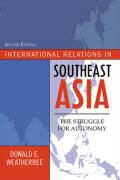Ulteriori informazioni
This balanced, comprehensive guide to Southeast Asian politics offers a sensible but nondogmatic realist approach to the region's international relations. In this revised, second edition, Donald E. Weatherbee lucidly explains the dynamics of the Southeast Asian subsystem as a struggle for autonomy in pursuit of national interests. He explores three important questions, the answers to which will shape the future Southeast Asia. Will democratic regimes transform international relations in Southeast Asia? Will national leaders succeed in reinventing ASEAN as a more effective collaborative mechanism? Finally, how will the evolving Chinese position, balancing and perhaps displacing the United States as Asia's great power, affect Southeast Asia's struggle for autonomy?
Sommario
Part 1 Introduction: The What and Why of Southeast Asia Chapter 2 Southeast Asia as an Interest Area Chapter 3 The Origins of the Southeast Asian Region Chapter 4 Defining the Southeast Asian Region Chapter 5 Diversities in Modern State Development Chapter 6 Region and Regionalism Chapter 7 The Study of International Relations in Southeast Asia Chapter 8 The Argument and Structure of the Book Part 9 The International Actors in Southeast Asia Chapter 10 Regional State Actors Chapter 11 Extraregional State Actors Chapter 12 Nonstate Actors Part 13 The Cold War in Southeast Asia Chapter 14 Containment in Southeast Asia Chapter 15 The Second Indochina War: 1961-1975 Chapter 16 Southeast Asia and the Second Indochina War Chapter 17 The Interwar Interval: 1975-1978 Chapter 18 The Third Indochina War Chapter 19 Southeast Asia at the End of the Cold War Part 20 ASEAN and Regionalism in Southeast Asia Chapter 21 ASEAN Enters into Its Fifth Decade Chapter 22 ASEAN's Blurred Blueprints Chapter 23 ASEAN's Organizational Development Chapter 24 ASEAN's External Relations Chapter 25 Subregional Multilateral Frameworks Part 26 Conflict and Conflict Resolution in Southeast Asia Chapter 27 The ASEAN Way Chapter 28 Intramural Disputes and Conflict in Southeast Asia Chapter 29 The South China Sea Conflict Zone Chapter 30 The International Dimensions of Ethnic Conflict Chapter 31 The ASEAN Regional Forum (ARF) Part 32 Transnational Violence and Crime in Southeast Asia Chapter 33 Terrorism Chapter 34 Transnational Crime Part 35 Southeast Asia in the Regional and International Economies Chapter 36 Intra-ASEAN Regionalism and AFTA Chapter 37 Patterns of ASEAN Trade and Investment Chapter 38 Economic Regionalism Beyond AFTA Chapter 39 Economic Regionalism Beyond ASEAN Part 40 Human Security in Southeast Asia's International Relations Chapter 41 Human Needs and Human Security Chapter 42 Human Rights and Human Security Part 43 Environmental Issues in International Relations in Southeast Asia Chapter 44 The Environmental Policy Setting Chapter 45 Deforestation Chapter 46 The "Haze" Chapter 47 The Maritime Zones Chapter 48 Rivers, Dams, and Ecosystems Part 49 Conclusion: Nation-States, ASEAN, and Autonomy Chapter 50 The State as Actor Chapter 51 Where Does ASEAN Fit In? Chapter 52 The ASEAN Communities Chapter 53 The Nontraditional Agenda Chapter 54 Transformations in the Regional International Environment Chapter 55 The Subordinate Regional State System Part 56 Index

